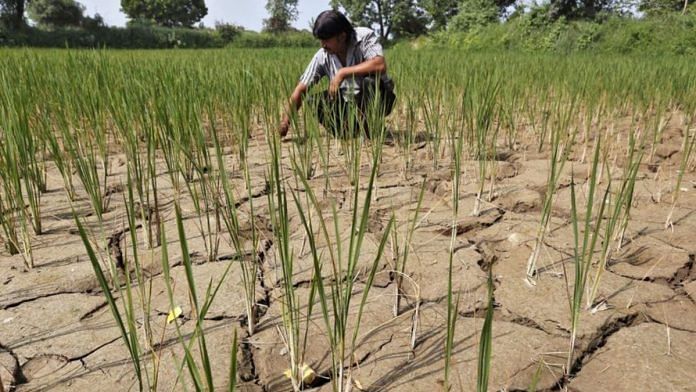New Delhi: The 2023-24 El Niño, one of the top five strongest on record, is weakening and there is a high chance we’ll experience normal conditions in April-June this year, said the World Meteorological Organization (WMO) on 5 March. The weather phenomenon, responsible for India’s driest monsoon since 2018, is still expected to impact weather patterns this year before it wanes by June.
The India Meteorological Department (IMD), too, held a press conference last week on the warm winters we experienced in 2024, and how El Niño played a role in that.
The El Niño is usually linked to above-normal temperatures, warm winters, and low rainfall which were all observed in the last year.
“El Niño is expected to wane by June, which is when the Indian monsoon officially starts. We are expecting a neutral monsoon season, with no El Niño or La Niña predicted as of now,” said IMD Director General of Meteorology M. Mohapatra to ThePrint. “But you’ve seen it has already impacted the winters of 2024, and we can expect weather fluctuations in the summer too,” he added.
So, what is the El Niño phenomenon and how does it affect weather and climate patterns around the world? ThePrint explains.
Also read: India saw 329 heatwave days in 2 yrs, media coverage lukewarm — 2 reports highlight dual challenge
What is El Niño
The El Niño is a climate pattern occurring in the Pacific Ocean in which trade winds — that take warm water from South America westwards to Asia — weaken. This weakening results in above-average high surface temperatures of the Pacific Ocean and has global impacts, with the main ones focused on countries near the tropics, including Latin America, South Africa, and South and Southeast Asia.
El Niño is part of the larger El Niño Southern-Oscillation (ENSO) cycle which has three phases — the El Niño, the La Niña and a neutral phase.
El Niño and La Niña last for around 12 months each, with the 2023 El Niño developing around June-July 2023. La Niña is the opposite of El Niño and leads to colder than normal sea surface temperatures in the Pacific.
El Niño’s usual impact in South Asia is to bring lesser than normal rainfall, which India noticed. There was a 36 percent deficit in August 2023 rainfall. This year too, the month of January saw a 91 percent deficit in rainfall because the Western Disturbances — wind patterns causing rainfall in Northwest India — were limited by El Niño.
“Though there is no rule book, if you have El Niño conditions, warm air increases near the tropical region and it pushes the cold air towards the north. Due to such a large-scale feature, minimum temperatures were also higher-than-normal, making it a warm winter season in the country,” said Dr Mohapatra at the IMD press conference.
Impact on India
While the IMD predicts neutral conditions by the start of the monsoon season in India, experts say that El Niño isn’t the only thing that impacts India’s monsoon. Raghu Murtugudde, a professor of climate studies at Indian Institute of Technology (IIT) Bombay, points out that while India did experience a deficit in rainfall last year, it wasn’t uniform. September rainfall was 13 percent more than normal, and even in winter, February brought rains that offset the January deficit, he said.
One of the reasons for this variability could be the increasing warming of the Arctic region, which leads to changes in India’s rainfall. The impact of Arctic warming on the Indian monsoon has been studied by the National Centre for Polar and Ocean Research, Goa, in a paper in 2023. It showed that warmer and colder variations in the Arctic temperatures were correlated with stronger and weaker monsoons in India, respectively. Due to global warming, temperatures in the Arctic are rising faster than the global average, and this could have a sustained impact on Indian monsoons.
As for the monsoon of 2024, Murtugudde said it depends on how the summer of 2024 goes, and whether neutral conditions actually persist during the monsoon. The WMO report on 5 March also said that there is a possibility that La Niña conditions will begin this year, however, it is still uncertain.
“Under normal conditions, the waning of El Niño by June would mean there would be a regular monsoon season, however given the fluctuations we’ve seen in Indian rains, we can’t say anything for sure,” said Murtugudde.
Last year, the disruption in Indian rainfall led to a loss in agriculture and India had to curb rice shipments, as well as impose 40 percent duty on onion exports and import pulses duty-free.
Other impacts & global warming
Though El Niño effects are expected to wane by the end of the summer, there continue to be warnings by the IMD about high temperatures. An IMD report in 2024 said that above-normal maximum temperatures and also heatwave days are to be expected in the country from March to May this year.
“This El Niño wasn’t the strongest one ever, but it is significant because it also aligned with global warming to increase temperatures,” said Dr Murtugudde.
He points to the record-breaking temperatures in 2023, which was the hottest year on record. Apart from atmospheric temperatures, even sea-surface temperatures (SST) were very high in January 2024, which WMO Secretary-General Celeste Saulo said cannot be attributed to El Niño alone, and need to take global warming into account.
(Edited by Zinnia Ray Chaudhuri)
Also read: What is AMOC & why scientists are alarmed by this crucial ocean current nearing tipping point



